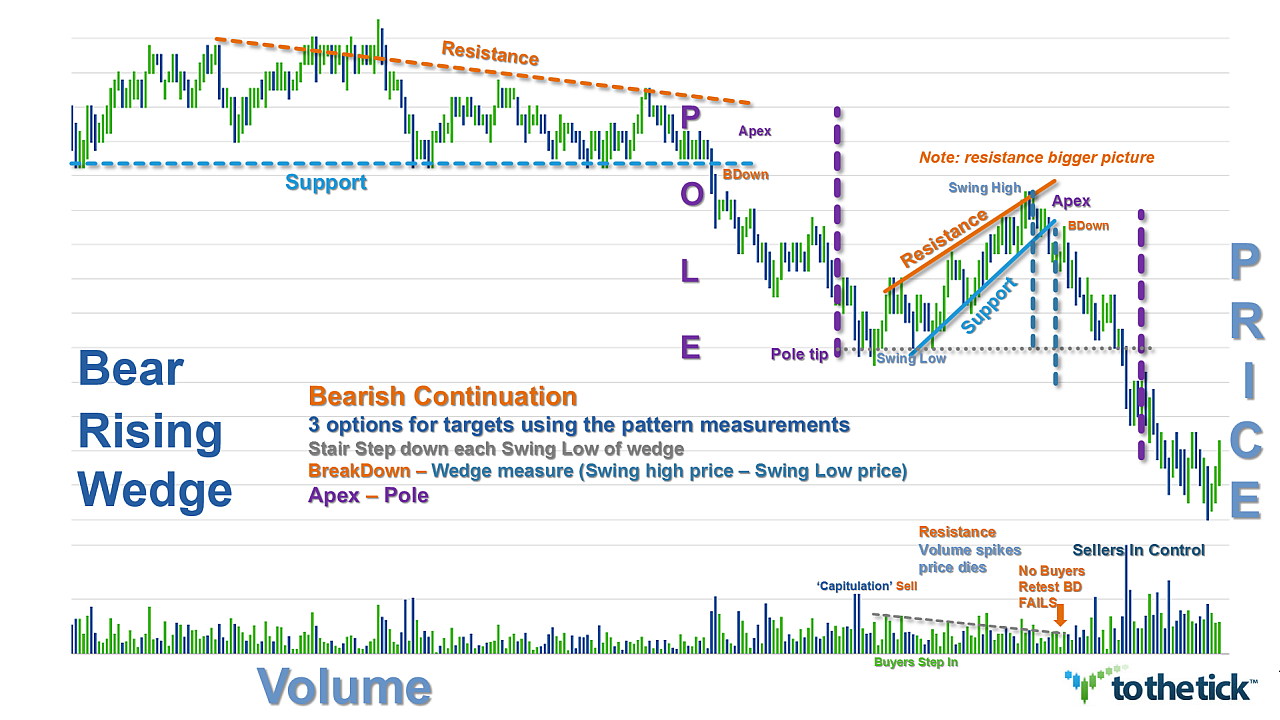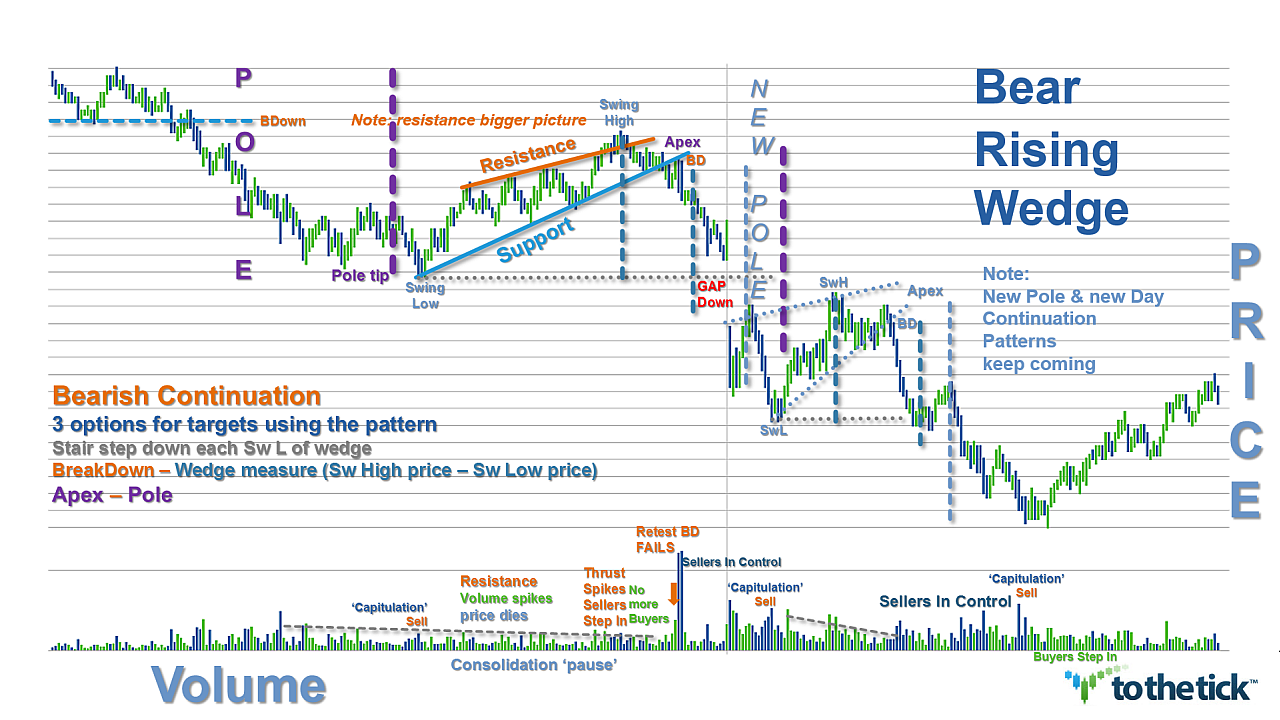The Rising Wedge as a price pattern is fairly common and presents in all markets, time frames, & price ranges. Typically a Rising Wedge is presented as either a bearish trend continuation pattern or a reversal pattern depending on the trading environment in the background. Regardless of environment the contracting, narrowing price range outlined by the Rising Wedge is an indication that the immediate uptrend is losing strength and considered to have a definite bearish bias.
Visually Rising Wedges are characterized by a contracting range in prices with ‘converging’ or inclining toward each other, trendlines that create higher lows & higher highs. By definition this means the Rising Wedge pattern outlines an immediate uptrend pattern in prices with both the immediate support & resistance trendlines slanted in the opposite direction of the larger bearish trend. The shape of the Rising Wedge is altered by the slope of the ascending resistance line which should be tighter than the steeper angle slope of the lower ascending support line.
Rising Wedges vary in their duration, but will have at least two swing highs and two swing lows in price. Traders should be prepared to adjust the trendlines as needed with additional swings. Volume usually diminishes as the pattern develops & this becomes one of the best keys to determine when the pattern may break & it represents the bearishness of the formation. If volume remains the same or increases during the wedge formation then the signal will be less reliable. Buyers & sellers create this narrowing range-bound price action and eventually prices squeeze to an Apex. The closer to the apex price gets the odds for a breakdown of the immediate price range becomes more likely.
Rising Wedges can be a little tricky to identify & to trade but traders can ‘stack the deck’ increasing the risk-to-reward ratio for profits when this pattern presents as a bearish continuation seen in a downtrend.
The bearish continuation pattern has 3 phases:
1) Background: A Strong impulsive, thrusting action with a surge in volume & price establishes a clear picture of the controlling bearish trend direction. In our rising wedge price pattern it is represented visually by a Pole. Deeper and more drama the better as the Pole is the Key to recognizing the potential for the continuation of the bearish pattern. The Pole represents trend direction as well as its strength & often this pattern is initiated as a new breakdown in price from an established area & sellers are in control.
2) The second phase is a pause for consolidation of the action both in volume & price and is represented by the rising wedge. As traders we like to see this phase short in duration with only 2 or 3 swings while our price action is range bound maintaining the higher lows & higher highs shape and the volume is ‘resting’. Again, pay close attention to the volume action with each push into the tightening slope of the resistance line which is an indication of weakening demand & offers clues to the bearishness of the pattern.
3) The pattern confirms as a bearish continuation pattern if the action creates a new bearish breakdown with a surge again from the bears in both volume & price. The immediate lower support outlined by the rising wedge is the area traders look to see confirm the breakdown. Typically the action will mimic the volatility & energy experienced with the Pole creation & volume considerations aid in recognizing further potential for the pattern. Often with a bearish breakdown pattern the reaction in volume is ‘delayed’ & price pullbacks to ‘re-test’ are common.
Options for Trading the Rising Wedge as a bearish continuation pattern:
There are two methods of trading this pattern & it depends on your trading style.
Aggressive traders will find the rising wedge to be a little tricky to trade before a breakdown actually occurs primarily because of the rising support line. However, as a bearish continuation trade the background resistance seen in the larger downtrend offers clues when combined with the tightening slope of the immediate upper resistance trendline created by the wedge. As the price action tightens in this area it is an indication of the lack of any real conviction from buyers. Aggressive entries short in this zone are available with the concept being the trend is on your side & the bears are maintaining a ‘wall of resistance’ & again, closely monitor the reactive volume with each push into this resistance zone for clues.
This can be an accurate trade that usually has a great risk:reward ratio. Stop placement can be fairly tight right above resistance & can be adjusted downward accordingly. When price approaches the lower ascending support line you should gauge the momentum: if you see that the momentum is strong stick to the position. However, if you see that support prevails, close the trade & take your profits to maximize the reward.
The aggressive trading method can highly increase the profit potential of any rising wedge. However, the trader needs to assess whether the ‘extra’ potential profits choosing the earlier entry offers a decent risk:reward over waiting for the breakdown of the rising support line. Remember that as a trend continuation pattern traders want this consolidation rising wedge formation to be relatively brief. Two or 3 swings may turn into more and the ‘spread’ or range in prices offered to the Apex should aid trade consideration. Traders want to see momentum weakening as prices squeeze to the Apex.
Conservative traders will use the more traditional method & will enter a short trade once the lower ascending support line has been broken &/or the new breakdown has confirmed.
All traders should be prepared for re-trace activity or a reaction rally to test the newly created breakdown or resistance level. An expansion of bearish volume can aid confirmation. False breakouts do happen & confirmation needed is always a traders’ choice. Several methods that apply here for either intrabar &/or close bar options offered in sequence: breakdown below support price, retrace holds new resistance line, price clears breakdown swing low, price clears next swing low of wedge pattern, larger chart combination.
Stop placement considerations can be aggressively lowered after the breakdown of the price.
Measured Move Targets based on structure of Pole & the Bear Rising Wedge
Aggressive with Momentum & Volume: duplication of the original move or trader choice measurement of the Pole:
- Apex or BreakDown price (minus) Pole measure = target
- Pole measure = (Pole Base price (minus) Pole Tip price)
Conservative:
- Apex or BreakDown price (minus) Rising Wedge measure = target
- Rising Wedge measure = (swing high price of wedge (minus) swing low price of wedge)
Additional target considerations based on the Rising Wedge pattern itself are each swing low that created the pattern as price stair-steps its way down to & including the re-test of the swing low of the Rising Wedge pattern or Pole Tip price.
Examples: Rising Wedge as a bearish continuation pattern:

